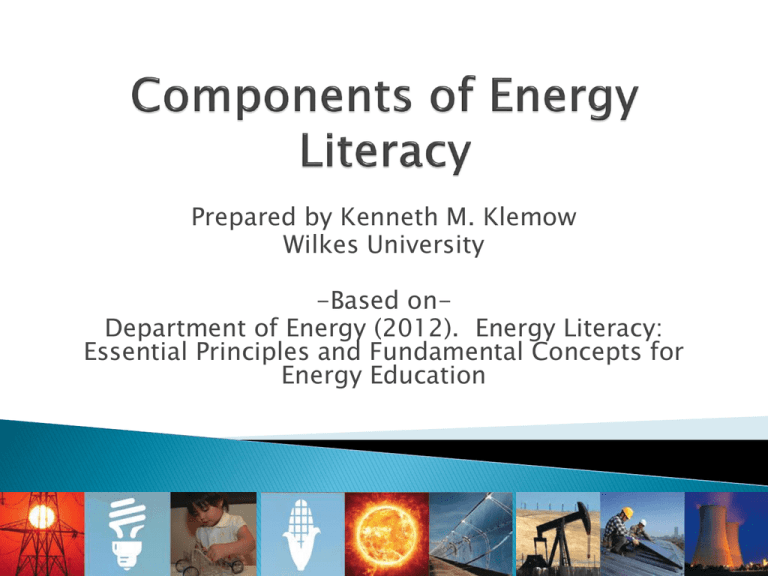Components of Energy Literacy according to the DOE
advertisement

Prepared by Kenneth M. Klemow Wilkes University -Based onDepartment of Energy (2012). Energy Literacy: Essential Principles and Fundamental Concepts for Energy Education An understanding of the nature and role of energy in the universe and in our lives. The ability to apply this understanding to answer questions and solve problems. Can trace energy flows and think in terms of energy systems Knows how much energy he or she uses, for what, and where the energy comes from Can assess the credibility of information about energy Can communicate about energy and energy use in meaningful ways Is able to make informed energy and energy use decisions based on an understanding of impacts and consequences Continues to learn about energy throughout his or her life A comprehensive study of energy must be interdisciplinary. ◦ Energy issues cannot be understood and problems cannot be solved by using only a natural science or engineering approach. ◦ Energy issues often require an understanding of civics, history, economics, sociology, psychology, and politics in addition to science, math, and technology. ◦ Just as both social and natural science are a part of energy literacy, energy literacy is an essential part of being literate in the social and natural sciences. References to energy can be found in National Education Standards in nearly all academic disciplines. A better understanding of energy can: ◦ Lead to more informed decisions ◦ Improve the security of a nation ◦ Promote economic development ◦ Lead to sustainable energy use ◦ Reduce environmental risks and negative impacts ◦ Help individuals and organizations save money Can be transferred from system to system. The energy of a system or object that results in its temperature is called thermal energy. Can neither be created nor destroyed. Energy available to do useful work decreases as it is transferred from system to system. Comes in different forms and can be divided into categories. Chemical and nuclear reactions involve transfer and transformation of energy. Measured by different units. Sunlight, gravitational potential, decay of radioactive isotopes, and rotation of the Earth drive physical processes on Earth. Earth’s weather and climate are driven by energy from the Sun. Water plays a major role in the storage and transfer of energy. Greenhouse gases affect energy flow. The Sun is the major source of energy for organisms and the ecosystems of which they are a part. Food is a biofuel used by organisms to acquire energy for internal living processes. Energy available to do useful work decreases as it is transferred from organism to organism. Energy flows through food webs in one direction, from producers to consumers and decomposers. Ecosystems are affected by changes in the availability of energy and matter. Humans are part of Earth’s ecosystems and influence energy flow through these systems. Humans transfer and transform energy from the environment into useful forms. Human use of energy is subject to limits. Fossil and biofuels are organic matter that contain energy captured from sunlight. Humans transport energy from place to place. Humans generate electricity in multiple ways. Humans store energy for later use in different ways. Energy sources, storage, and transport forms each have different benefits and drawbacks. Decisions concerning the use of energy resources are made at many levels. Energy infrastructure has inertia. Energy decisions can be made using a systems-based approach. Energy decisions are influenced by ◦ ◦ ◦ ◦ Economic factors Political factors Environmental factors Social factors We manage energy resources through conservation. Human demand for energy is increasing. Earth has limited energy resources. The amount of energy used is affected by: ◦ Social and technological innovation ◦ Behavior and design Products and services carry with them embedded energy. ◦ Life cycle analyses important. Amount of energy used can be calculated and monitored. Impacts include ◦ ◦ ◦ ◦ ◦ ◦ ◦ ◦ Economic security National security Environmental quality Health Education access Socioeconomic status Gender equality Global partnerships Supply and demand for fossil fuels especially important. Some populations more vulnerable to impacts of energy choices than others. Contact: US Department of Energy 1000 Independence Ave., SW Washington, DC 20585 202-586-5000 Http://www1.eere.energy.gov/education/energy_literacy.html











